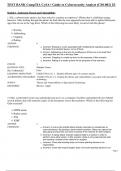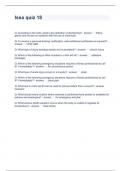Exam (elaborations)
Test Bank CompTIA CySA+ Guide to Cybersecurity Analyst (CS0-002) 2nd Edition by Mark Ciampa. Isbn. 9780357678091. 9780357678107. Full Chapters
- Course
- Institution
Test Bank for CompTIA CySA+ Guide to Cybersecurity Analyst (CS0-002) 2nd Edition by Mark Ciampa. Isbn. 9780357678091. 9780357678107. CompTIA CySA+ Second Edition Test Bank. CompTIA CySA+ Guide to Cybersecurity Analyst 2nd Edition Test Bank. Part 1: EXTERNAL THREATS & INTERNAL VULNERABILITIES 1. ...
[Show more]




